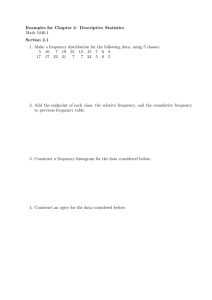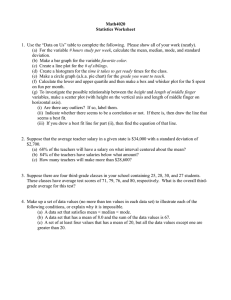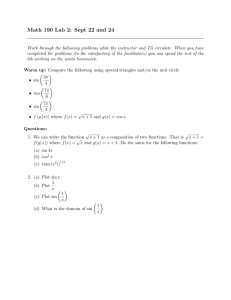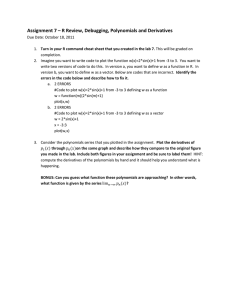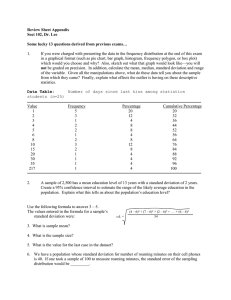MASSACHUSETTS INSTITUTE OF TECHNOLOGY Department of Civil and Environmental Engineering
advertisement
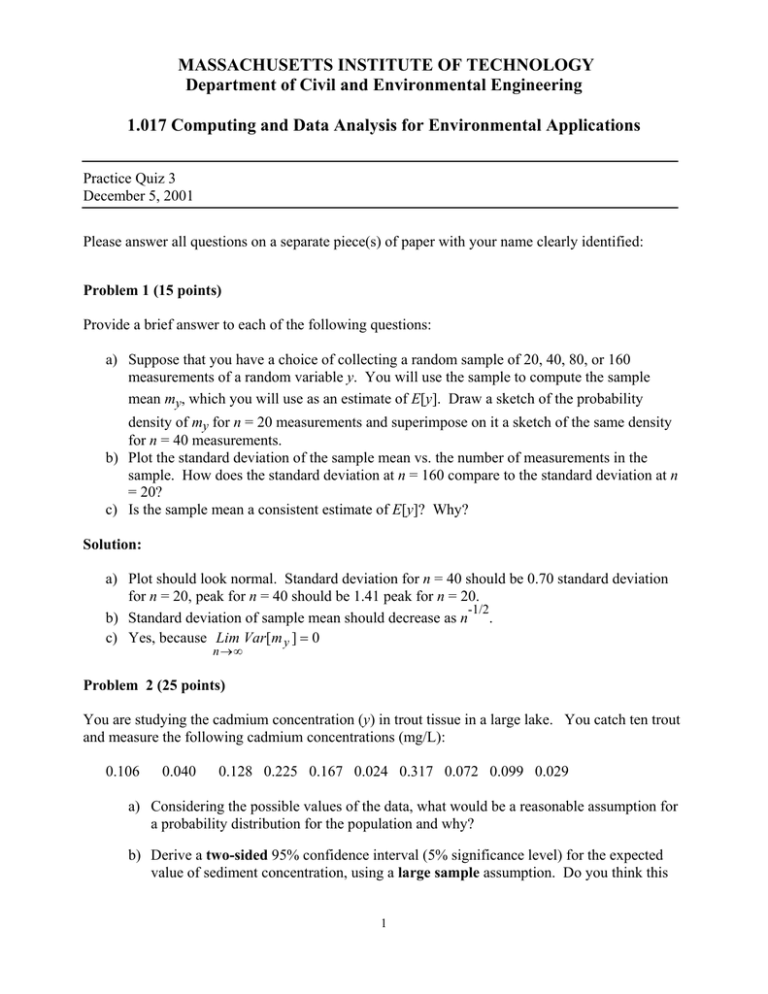
MASSACHUSETTS INSTITUTE OF TECHNOLOGY Department of Civil and Environmental Engineering 1.017 Computing and Data Analysis for Environmental Applications Practice Quiz 3 December 5, 2001 Please answer all questions on a separate piece(s) of paper with your name clearly identified: Problem 1 (15 points) Provide a brief answer to each of the following questions: a) Suppose that you have a choice of collecting a random sample of 20, 40, 80, or 160 measurements of a random variable y. You will use the sample to compute the sample mean my, which you will use as an estimate of E[y]. Draw a sketch of the probability density of my for n = 20 measurements and superimpose on it a sketch of the same density for n = 40 measurements. b) Plot the standard deviation of the sample mean vs. the number of measurements in the sample. How does the standard deviation at n = 160 compare to the standard deviation at n = 20? c) Is the sample mean a consistent estimate of E[y]? Why? Solution: a) Plot should look normal. Standard deviation for n = 40 should be 0.70 standard deviation for n = 20, peak for n = 40 should be 1.41 peak for n = 20. -1/2 b) Standard deviation of sample mean should decrease as n . c) Yes, because Lim Var[m y ] = 0 n→∞ Problem 2 (25 points) You are studying the cadmium concentration (y) in trout tissue in a large lake. You catch ten trout and measure the following cadmium concentrations (mg/L): 0.106 0.040 0.128 0.225 0.167 0.024 0.317 0.072 0.099 0.029 a) Considering the possible values of the data, what would be a reasonable assumption for a probability distribution for the population and why? b) Derive a two-sided 95% confidence interval (5% significance level) for the expected value of sediment concentration, using a large sample assumption. Do you think this 1 assumption is justified? Why? Note that the 2.5% lower and upper critical values for a unit normal probability distribution are –1.96 and +1.96. c) Carry out a two-sided large sample test of the hypothesis H0: E[y] = 0.2. Is H0 accepted or rejected at a 5% significance level? Solution: a) A histogram of the data suggest that y is exponentially distributed. b) Sample mean is my = 0.12 Sample standard deviation is sy = 0.094 If we adopt a large sample approximation we assume that the sample mean is normally distributed with mean E[my] = E[y] ((the unknown true mean) and standard deviation SD[my] = sy/n1/2 = 0.094/(10)1/2 = 0.03. The critical points for a two-sided 95% confidence interval are given by: myl,0.95 = my - SD[my](1.96) = 0.12 - (0.03)(1.96) = 0.063 myu,0.95 = my + SD[my](1.96) = 0.12 + (0.03)(1.96) = 0.18 So we infer from the data that E[y] probably lies in the interval between 0.063 and 0.18. Based on our experience with stochastic simulation of small exponential samples, the large sample approximation is reasonably good for samples as small as n = 10 at significance levels of 0.05 or larger. c) Find the two-sided large sample acceptance region for a significance level of 5% from: myl,0.95 = E[y|H0] - SD[my](1.96) = 0.2 - (0.03)(1.96) = 0.14 myu,0.95 = E[y|H0] + SD[my](1.96) = 0.2 + (0.03)(1.96) = 0.26 Since the sample mean estimate my = 0.12 lies outside the acceptance region we reject H0. Problem 3 (30 points) Consider the following 4 values of the independent variable (time) and the dependent variable (change in total dry biomass relative to long-term average) in a temperate forest: Time (months): 2.0 2.5 4.0 8.0 Biomass (Kg/m2): 2.7 3.3 -1.6 9.0 Compare the following two regression models by following the indicated steps: y L ( x, a 2 ) = a 2 x 2 y S ( x, a 2 ) = a 2 Sin( x) a) For each model, derive the least-squares estimate for a2. You can do this by minimizing the sum-of-squares error directly or by using the following expression: H ′Hâ2 = H ′y where: H = [ x1,…, x4 ] = [2.0 2.5 4.0 H = [ sin(x1),…, sin(x4)] = [ 0.91 8.0 ] 0.60 for the first model -0.76 0.99 ] for the second model b) Plot the regression line over the range of measurement x values and calculate the sum-ofsquared errors or SSE (the easiest way to do this is to read the error values directly off your plot). Which line gives a smaller SSE? c) Which regression model do you prefer? Why? Solution: % Quiz 3, Solution to Problem 4 function quiz01_3sol4 % generate data xmeas=[2,2.5,4,8] ymeas=xmeas.*sin(xmeas)+2*normrnd(0,1,1,4) hL=xmeas' hS=sin(xmeas)' a2Lhat=inv(hL'*hL)*(hL'*ymeas') a2Lhat=(hL'*hL)\(hL'*ymeas') a2Shat=(hS'*hS)\(hS'*ymeas') SSEL=(ymeas-a2Lhat*xmeas)*(ymeas-a2Lhat*xmeas)' SSES=(ymeas-a2Shat*sin(xmeas))*(ymeas-a2Shat*sin(xmeas))' x=[1:.01:9]; yL=a2Lhat*x; yS=a2Shat*sin(x); close all figure plot(xmeas,ymeas,'*') hold on plot(x,yL,'r') hold on plot(x,yS,'b') return 3 a2Lhat = 0.8781 a2Shat = 5.3151 SSEL = 32.1493 SSES = 24.4308 Problem 4 (30 points) Consider the following random sample of 6 measurements of a random variable y distributed uniformly between 0 and c: 0.8775 0.0319 0.8537 0.7946 0.3409 0.0080 a) Use this sample to derive an appropriate estimate of c, the upper bound of the random variable y. b) Write a stochastic simulation program that evaluates and plots on a normal probability scale the cumulative distribution function of the estimator you used to compute c. c) Suppose that your program produces the following plot when a value of c = 1.5 is used in the uniform random number generator used to generate the replicates. Indicate on the plot (with lines and arrows) how you would derive the p value for a two sided test of the hypothesis H0: c = 1.5 when your estimate of c is obtained from the above sample. What is the p value? Would you reject the hypothesis? Why? d) Do you think a large sample approximation is valid for this hypothesis testing problem? Why? 4 Solution zeta = 0.9689 % Quiz 3, Solution to Problem 5 function quiz01_3sol5 % specify sample data and compute sample estimate samp=[ 0.8775 0.0319 0.8537 0.7946 0.3409 zeta=2*mean(samp) n=6 nrep=10000 close all c=1.5 % replicate loop for i=1:nrep ymc=unifrnd(0,c,1,n); cmc(i)=2*mean(ymc); end % construct CDF for hypothesized c normplot(cmc) return 5 0.0080] ξ = 0.97 p/2 = 0.05 p = 0.1 6
